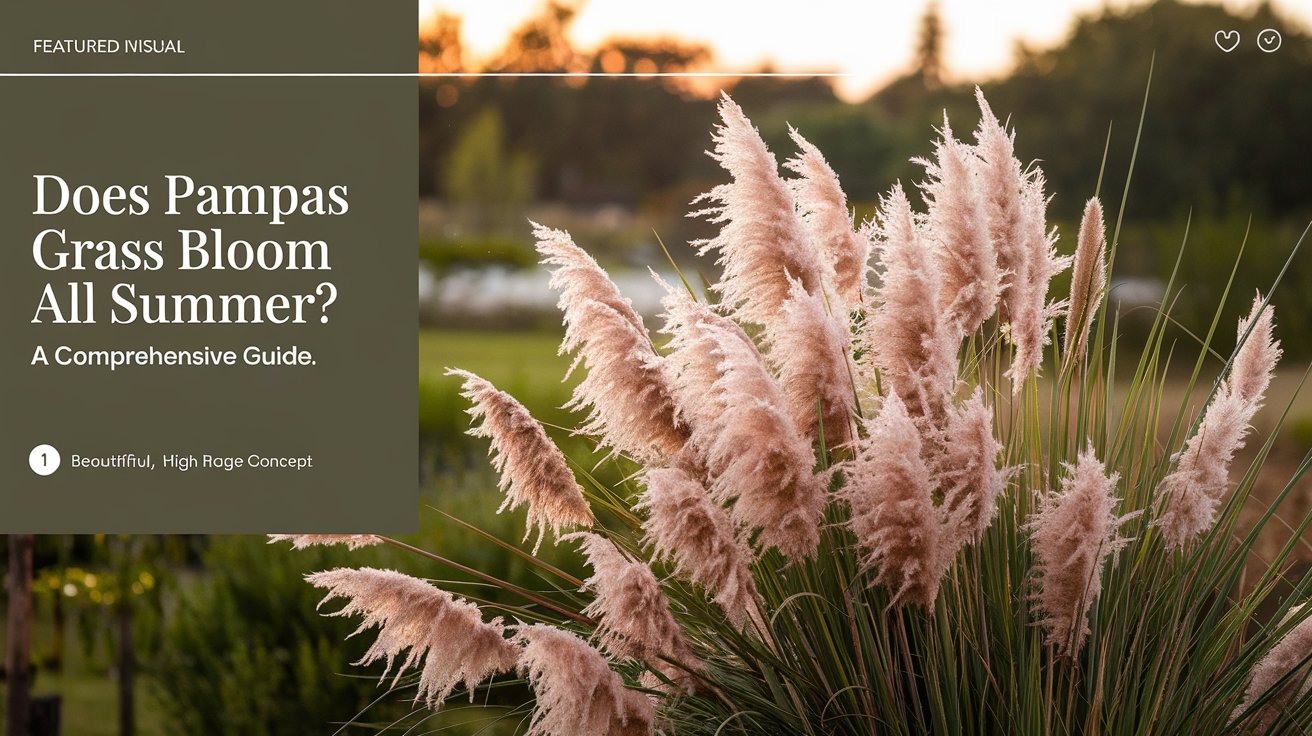Introduction
Pampas grass, known for its towering plumes and lush foliage, is a popular ornamental plant in gardens and landscapes. Its elegant, feathery blooms add texture and drama to any outdoor space. However, one of the most common questions among gardeners is, “Does pampas grass bloom all summer?” In this article, we’ll explore the blooming cycle of pampas grass, factors that influence its blooming period, and how you can ensure your pampas grass thrives throughout the season.
What is Pampas Grass?
Pampas grass (Cortaderia selloana) is a perennial grass native to South America, particularly Argentina, Brazil, and Chile. It’s known for its tall, arching leaves and large, plume-like flowers that can reach up to 10 feet in height. The plant’s striking appearance makes it a favorite in ornamental landscaping, where it’s often used as a focal point or for creating natural privacy screens.
Blooming Cycle of Pampas Grass
While pampas grass is renowned for its beautiful plumes, it does not bloom all summer. The blooming period typically occurs from late summer to early fall, with the most prolific flowering happening between August and October. The exact timing of the bloom can vary depending on the climate, the plant’s location, and growing conditions.
Factors Influencing the Blooming Period
- Climate and Temperature
- Pampas grass thrives in warm climates and requires plenty of sunlight to produce its iconic plumes. In regions with mild winters and hot summers, pampas grass tends to bloom more abundantly. However, in cooler climates, the blooming period might be shorter or less prolific.
- Soil Conditions
- Well-drained soil is crucial for the healthy growth of pampas grass. The plant prefers sandy or loamy soils that are slightly acidic to neutral. Poor soil drainage can lead to root rot, which can stunt the plant’s growth and affect its ability to bloom.
- Watering and Maintenance
- While pampas grass is drought-tolerant once established, regular watering during the growing season can promote healthy growth and blooming. However, overwatering can cause problems, so it’s essential to strike a balance. Additionally, removing dead leaves and spent blooms can encourage new growth and prolong the blooming period.
- Fertilization
- Applying a balanced fertilizer in the spring can give pampas grass the nutrients it needs to produce vigorous growth and abundant blooms. Be careful not to over-fertilize, as this can lead to excessive foliage growth at the expense of flowering.
Extending the Blooming Season
While pampas grass does not bloom all summer, there are a few strategies you can employ to maximize its flowering period:
- Planting in Optimal Locations
- Choose a location that receives full sun for most of the day. Pampas grass thrives in sunlight, and a well-lit area will encourage more robust blooming.
- Pruning and Deadheading
- Regularly pruning spent flowers and deadheading can help stimulate new growth and potentially extend the blooming period. It’s best to prune pampas grass in late winter or early spring before new growth begins.
- Providing Adequate Space
- Pampas grass can grow quite large, so ensure that it has enough space to spread out. Crowded plants may compete for resources, leading to reduced blooming.
Common Issues Affecting Blooming
Even with proper care, pampas grass may occasionally fail to bloom as expected. Here are some common issues that can affect the plant’s flowering:
- Insufficient Sunlight
- If your pampas grass is planted in a shady area, it may not receive enough sunlight to produce flowers. Consider relocating the plant to a sunnier spot if possible.
- Poor Soil Quality
- Compacted or poorly drained soil can prevent the plant from thriving. Amending the soil with organic matter or relocating the plant to a more suitable location may help.
- Pests and Diseases
- While pampas grass is generally resistant to pests, it can occasionally suffer from fungal diseases, particularly in humid climates. Treating the plant with fungicides or removing affected areas can help prevent these issues from affecting blooming.
FAQs
Here are the top 5 FAQs for the keyword “Does pampas grass bloom all summer?”:
1. When does pampas grass typically start blooming?
- Answer: Pampas grass usually begins to bloom in late summer, typically around August, and continues through early fall, with the most vibrant plumes appearing between August and October.
2. Can I extend the blooming period of pampas grass?
- Answer: While you can’t make pampas grass bloom all summer, you can extend its blooming period slightly by ensuring it gets plenty of sunlight, watering it appropriately, and regularly pruning spent flowers to encourage new growth.
3. What factors affect the blooming of pampas grass?
- Answer: Several factors influence the blooming of pampas grass, including climate, soil quality, sunlight, watering, and proper maintenance. It thrives in warm climates with well-drained soil and full sunlight.
4. Why is my pampas grass not blooming?
- Answer: Pampas grass may fail to bloom due to insufficient sunlight, poor soil conditions, overwatering, or pest and disease issues. Ensuring the plant is in a sunny location with well-drained soil and proper care can help it bloom.
5. Does pampas grass bloom in its first year?
- Answer: Pampas grass may not bloom in its first year after planting, as it often focuses on establishing roots and foliage. It typically starts blooming from the second year onward, depending on the growing conditions.
Conclusion
So, does pampas grass bloom all summer? The answer is no, but with the right care and conditions, you can enjoy its stunning plumes from late summer into the fall. By understanding the factors that influence its blooming period and following proper care guidelines, you can ensure your pampas grass remains a showstopper in your garden year after year.
Whether you’re a seasoned gardener or new to cultivating ornamental grasses, pampas grass offers a rewarding experience with its majestic blooms. With a little attention to its needs, you can create a beautiful and lasting display that enhances your outdoor space.


